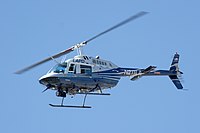
Photo from wikipedia
OBJECTIVES To evaluate the efficacy of a novel mount with torque control for tightening of Osstell® transducers and to determine the reliability of recorded ISQ measurements from implants placed in… Click to show full abstract
OBJECTIVES To evaluate the efficacy of a novel mount with torque control for tightening of Osstell® transducers and to determine the reliability of recorded ISQ measurements from implants placed in various bone densities. MATERIAL AND METHODS: Fifty-six implants, comprising seven different implant types, were placed in eight polyurethane blocks representing D1, D2, D3, and D4 bone densities. Resonance frequency analysis (RFA) transducers were attached to each implant in four different ways: (a) hand tightening, (b) hand tightening with a SmartPeg Mount™, (c) hand tightening using the novel mount with torque control (SafeMount) and (d) tightening to 6 Ncm with a calibrated torque device. ISQ measurements were taken and a second operator repeated the measurements. Intraclass correlation coefficient (ICC) was calculated to assess the reliability of the measurements and linear mixed effects regression was employed to determine the effect explanatory variables had on ISQ values. RESULTS There was a statistically significant difference in ISQ values obtained by hand tightening transducers compared to the calibrated torque device p < .001, 95%(-2.89, -1.21) but not between any other tightening methods. There was excellent agreement between the two RFA devices (ICC 0.986) and between buccal and mesial measurements (ICC 0.977). For all transducer tightening methods there was excellent inter-operator agreement in D1 and D2 (ICC > 0.8) but very poor agreement in D4 (ICC < 0.24). Bone density accounted for 36% of the variation in ISQ values, the implant for 11% and the operator for 6%. CONCLUSIONS SafeMount, did not significantly improve the reliability of the RFA measurements when compared to the standard mount, but calibrated torque devices seem to have benefits when compared to tightening the transducers by hand. Results also indicate that the ISQ values should be interpreted with caution when measuring implant stability in poor quality bone regardless of the implant geometry.
Journal Title: Clinical and experimental dental research
Year Published: 2023
Link to full text (if available)
Share on Social Media: Sign Up to like & get
recommendations!